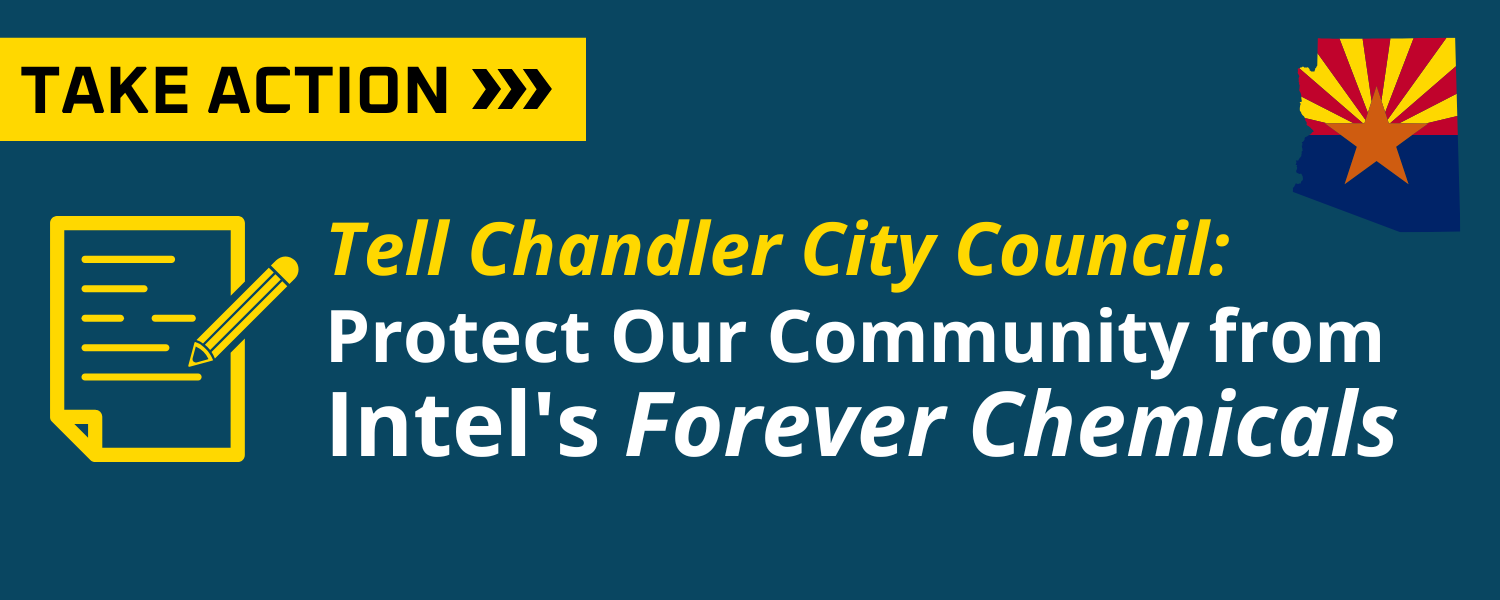Chandler Residents to City Council: Protect Our Community from Intel's Forever Chemicals
Mayor Kevin Hartke, Vice Mayor Christine Ellis, Councilmember Angel Encinas, Councilmember OD Harris, Councilmember Jennifer Hawkins, Councilmember Matt Orlando, Councilmember Jane Poston

We are asking the following from Intel:
Quarterly monitoring of 40 PFAS chemicals.
Public reporting of monitoring results, so the public can be assured that Intel is not releasing toxics into our surface waters or public treatment works.
A commitment to screen out all PFAS before sending wastewater from the facility.
A commitment to destroy the PFAS using best available technologies.
Water is uniquely precious in Arizona, a state that has been in a condition of long-term drought for over thirty years. In order to protect this vital natural resource, we need to go upstream and ensure that polluters clean up their own wastewater. As residents of City of Chandler, we call on you to step in and take action!
To:
Mayor Kevin Hartke, Vice Mayor Christine Ellis, Councilmember Angel Encinas, Councilmember OD Harris, Councilmember Jennifer Hawkins, Councilmember Matt Orlando, Councilmember Jane Poston
From:
[Your Name]
Dear Mayor and Council Members,
As Chandler residents, we urge you to protect our community and our neighbors from toxic “forever chemicals” – PFAS – in the wastewater from Intel Corporation’s Ocotillo Campus. Intel’s wastewater pretreatment permit with the City of Chandler expires on June 30, 2025. Discussions with City of Chandler staff suggest that PFAS were not considered in renewal of this permit. This is a huge oversight.
While Intel has been operating in Chandler since 1980, the dangers of PFAS have only become understood more recently. We urge the city to revisit its pretreatment permit and strengthen protections from these highly toxic chemicals before this permit’s next renewal cycle (June 30, 2026.).
The dangers of PFAS
PFAS (per and poly fluoroalkyl substances) are known as “forever chemicals,” because they persist in our bodies, waterways, plants, and wildlife – for decades or possibly longer. There is no safe level of these persistent chemicals, which have been found to cause a variety of cancers, reproductive disorders, and other serious health impacts.
PFAS at Intel
We don’t know which PFAS chemicals Intel uses, due to the company’s secrecy, but the semiconductor industry has identified over a thousand uses of the chemicals in manufacturing and its supply chain. In exchange for $7.86 billion from the federal government under the CHIPS and Science Act (about $4 billion for the Chandler fabs), Intel promised to “segregate known process organic waste containing per- and polyfluoroalkyl substances (PFAS) from facility waste streams to a closed bulk storage system for off-site management by treatment and disposal facilities.” We are heartened by this commitment and call for monitoring and reporting to confirm that no PFAS enters public waste streams and ask for destruction of PFAS using best available technologies.
PFAS in our drinking water
PFAS used in chip-making ends up in our water, soil, and food. In the few cases when the effluent (wastewater) of chip-makers has been tested, many PFAS chemicals have been detected. (In Essex Junction, Vermont, semiconductor manufacturer GlobalFoundries claimed to be removing PFAS, and yet testing found the chemicals in the factory’s effluent.) Without regulatory limits on PFAS discharges, Intel’s wastewater is likely sending the toxic chemicals to the City of Chandler’s sanitary sewer system and to our groundwater. Since wastewater plants are not currently equipped to remove PFAS, the dangerous chemicals either end up in biosolids (used as agricultural fertilizer), in landfills (where they can leach into the groundwater), incinerated (where they can turn into an airborne poison), or back in our waterways. Studies have found that PFAS in wastewater often ends up in drinking water.
PFAS in Chandler
Intel’s most recent pretreatment permit with the City of Chandler does not mention PFAS. These chemicals are not among the toxic compounds that the company is required to sample for and limit as part of its compliance process. We understand that federal regulations do not require limits on PFAS in wastewater, but the science is clear. We do not need to wait for federal regulations to adopt protective policies for wastewater. (Twelve states limit PFAS in industrial discharge, four others are in the planning stage, and five are considering it. In states without regulations, publicly owned treatment works have begun requiring polluters to screen PFAS from their wastewater and monitor for it. Approximately 1,600 treatment facilities already use pretreatment permits to limit the flow of industrial pollutants.)
Our request
We call on the City of Chandler to protect our community and neighboring cities from the PFAS chemicals used by Intel. The Clean Water Act gives wastewater plants the authority to require polluters to remove PFAS before sending wastewater to treatment plants for further treatment. Please direct your staff to include PFAS in the wastewater pretreatment permit 2026 renewal. A permit that is appropriately protective should require:
Quarterly monitoring of PFAS chemicals using EPA’s Method 1633, which tests for 40 of the best-known chemicals.
Public reporting of monitoring results, so the public can be assured that Intel is not releasing toxics into our surface waters or public treatment works.
A commitment to screen out all PFAS from effluent before sending wastewater from the facility.
A commitment to destroy the segregated PFAS using best available technologies.
Conclusion
Water is uniquely precious in Arizona, a state that has been in a condition of long-term drought for over thirty years. In order to protect this vital natural resource, we need to go upstream and ensure that polluters clean up their own wastewater.
